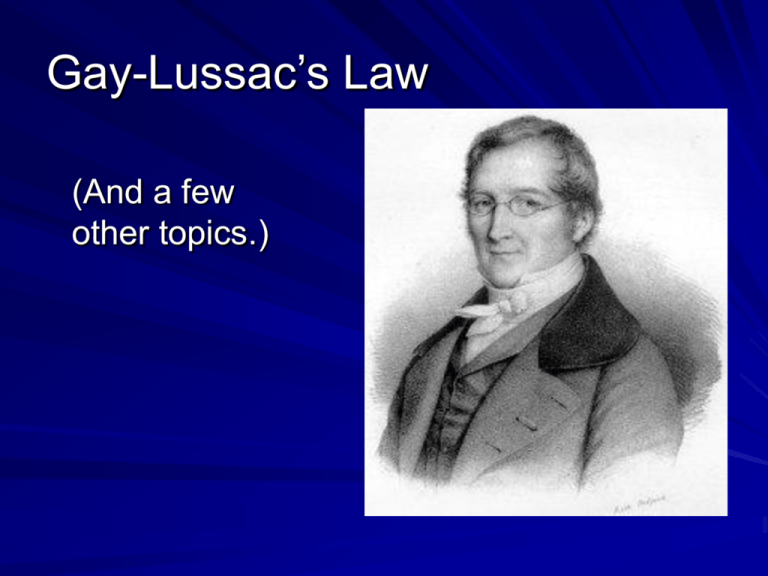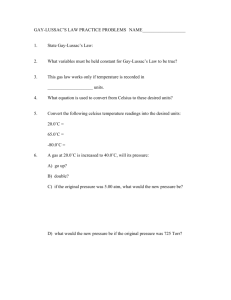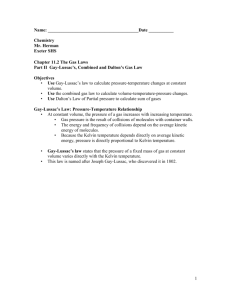Regents Unit 5: Gay
advertisement

Gay-Lussac’s Law (And a few other topics.) Gay-Lussac was a balloonist. Gay-Lussac (1778-1850) In 1802 he went up to 23,000 feet in a balloon – a record for 50 years. Wanted to investigate the composition of the atmosphere as a function of altitude. Gay-Lussac Examined relationship betw P & T at constant V and moles If T , the gas molecules will move faster, colliding with the walls more frequently & more energetically. Pressure results from collisions between gas molecules & walls of container. So, if T , we expect P . Gay-Lussac Tiger Graphic Which temperature scale has a direct relationship to molecular velocity? Kelvin Typical data from a Gay-Lussac type experiment. What kind of relationship is illustrated in this graph? T (K) Gay-Lussac’s Law Describes relationship between pressure & temperature at constant volume & amount. P = kT or P/T = k What kind of relationship is this? Straight line with y-intercept of zero. It’s direct. Gay-Lussac: Verbal The pressure exerted by a confined gas is directly related to the Kelvin temperature at constant volume. When temperature decreases, the pressure of a gas (decreases, increases, stays the same). Decreases When temperature increases, the pressure of a gas (decreases, increases, stays the same). Increases Gay-Lussac’s Law P1 = P2 T1 T2 Useful problem-solving format. Combined Gas Law Putting it all together: P1V1 = P2V2 T T2 1 For a fixed amount of gas. Combined Gas Law Given 5 of the 6 variables, you can identify the 6th. Do problems when more than 1 variable changes. If a variable is constant, just ignore it. Avogadro’s Hypothesis Equal volumes of gases at the same temperature and pressure contain equal numbers of particles. 3 containers – same size, same temperature, same pressure. Box A He Box B N2 Box C CH4 What can you say about the number of molecules in each box? It’s the same. What can you say about the number of atoms in each box? B = 2 X A & C = 5 X A Molar Volume 1 mole of any gas at STP occupies 22.4 L Diffusion At the same temperature, light molecules move faster than heavy molecules. At 25C, which gas molecules will move the fastest from the following: H2, He, N2, CO2, Xe Which will move the slowest? Dalton’s Law of Partial Pressure The total pressure of a mixture of gases = the sum of the pressures of all the gases in the mixture. The portion contributed by each gas is called the partial pressure of that gas. Ptot = P1 + P2 + P3 + P4 + … Pn Dalton’s Law Problems Given a mixture of 200 torr of He, 500 torr of N2, and 150 torr of Ne, what is the total pressure? Dalton’s Law Problems A mixture of O2, CO2, and N2 has a total pressure of 1800 torr. The partial pressure of the O2 is 380 torr and the partial pressure of the CO2 is 960 torr. What is the partial pressure of the N2? Ptot = P02 + PCO2 + PN2 Rearrange: PN2 = Ptot – PO2 – PCO2 PN2 = 1800 – 380 – 960 = 460 torr






